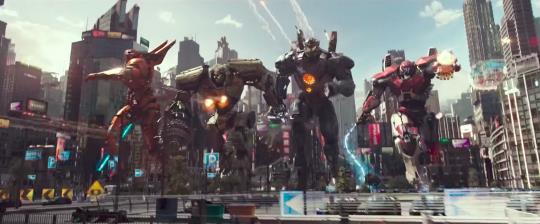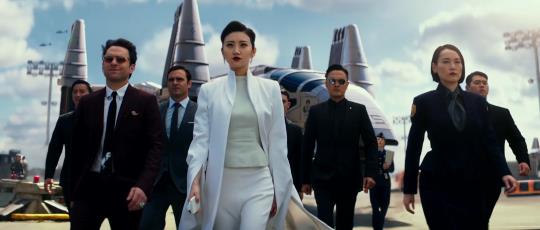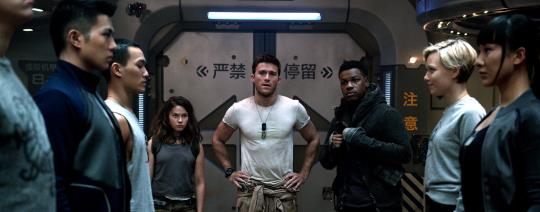Silver Screenings: Pacific Rim: Uprising

I don’t think Pacific Rim: Uprising knows who its core characters are. Based on promotional materials it’s most certainly banking on audiences recognizing John Boyega from the latest Star Wars films, and as such he is the closest thing we have to a central character. However, it does not build any sort of arc or partnership between he and the other two characters key to the climax in the same manner that the first film developed Mako Mori and Stacker Pentecost through the conduit personified by Raleigh.
This is, perhaps, the most curious aspect of the first film. Raleigh is positioned as the main character, but he’s more of a cipher. His arc is largely complete once he agrees to return and pilot a Jaegar. From then on the story is more about Mako, her drive to become a Jaegar pilot, and Pentecost’s simultaneous wish to keep her out of danger and to see his mission complete before he passes away. The climax brings these – and other relationships – to a… functional conclusion, though the satisfaction of it may vary depending on how much you care about the human drama.
If the climax is a dramatic pay-off that the entire film has been building towards, then the human drama of Uprising should have focused primarily on Jake Pentecost and his relationships with Amara Namani and Liwen Shao. In fact, the opening of the film would lead you to believe that Jake and Amara are the new Raleigh and Mako. That they don’t really have any meaningful interaction between the start and the climax speaks to the contrary. Liwen Shao herself is intentionally portrayed as cold a woman as possible so that she may serve as an obvious red herring. At no moment is she humanized or developed. She simply changes personalities as easily as one might swap socks.
This is because these characters do not exist for the narrative, but to fill some socio-political demographic. Liwen exists because Hollywood wants this film to make a lot of cash in China, where the first film was a big hit. If there are scenes depicting Liwen in a more sympathetic light, they are likely reserved for the Chinese cut where she has a much greater role in the central plot. The current American theatrical cut thinks audiences are stupid and that they’ll be fine with her heroic role once we know she isn’t the real villain. It does not matter that her dialogue presents such a cruel personality as to see benefit in someone’s death. That was necessary for the red herring, you see?
Amara herself is a ham-fisted attempt to self-insert a fan-girl type character, excitedly barking out the names of different Jaegars without expounding in detail what makes them so impressive. There’s more convincing geek talk on episodes of The Big Bang Theory. From that point on she exists in her own film filled with a diverse cast of cultural demographics.
Which is where this film fails to set up the final climax. While we bounce between Jake’s narrative and Amara’s, most of the time is spent with the former as he is piloting a Jaegar. His co-pilot, however, is an old friend played by Scott Eastwood with a bit of a grudge. The film cartoonishly establishes the conflict between these two, but a resolution is left to little more than an earnest look during a half-hearted speech. Suddenly the two are working well together simply because the film requires they to be the ones involved in action scenes, leaving Amara and company behind.

The one moment Jake and Amara share in the entire film is completely overshadowed by the first, as Uprising tries to recreate the first synchronization between Raleigh and Mako. If you ever wanted to understand how great of a director Guillermo Del Toro is and how much he understands filmmaking, this is the comparison to make. It is also a perfect comparison for any classroom attempting to illustrate the meaning of “show, don’t tell”. In Mako’s flashback we are witness to a solitary, crying child trying to hide from and flee a giant monster. We aren’t given the specifics, but there’s enough to inuit what has happened.
Pacific Rim: Uprising wants you to know specifically what happened, and the execution thereof is robbed of any horror through its predictability. You know precisely what is going to happen because Stephen S. DeKnight doesn’t know how to film the movie as if it’s not a movie, but an experience. Mako’s flashback still gets to me each time not because of the exposition it is trying to tell – it does that visually in a matter of seconds – but because of the experience it wants to pull you into. The oppressive size of the Kaiju furiously chasing the crying Mako pulls you into that alleyway.
Pacific Rim: Uprising reminds you that you’re sitting in a theater, feeding a cynical industry that thinks you’re an idiot.
I want to make it clear that I do not hate the fact that characters like Amara or Liwen exist, though any testament is pointless to any who might want to claim me some bigot. Amara and the remaining cadets aren’t a problem because they’re diverse. It’s that their cynical, shallow inclusion is clearly a checkmark. “Cool, we’re diverse, now the Liberal viewers will shut up”. These characters lack dimension and simply act as the script needs in that moment, which makes it less of a film and more of a product.
The same goes for Liwen. Her goal of creating drones could have opened up a lot of interesting philosophical discussions, but she was included to ensure a market was appeased with goals haphazardly pieced together to generate a conflict.

Perhaps what infuriates me most is that Pacific Rim: Uprising contains a number of ideas that could have made a really fascinating film. If we’re being frank the original Pacific Rim was not the smartest movie. It was made by a man very in touch with his inner child; an inner child excitedly grasping his Ultraman action figure – or closest bootleg comparison – while watching old and wrinkly VHS recordings of the show off of TV. It was a callback to a very specific type of film with modern blockbuster sensibilities, and while it carries many flaws inherent to that combination, it also manages to deliver in a way those older films never could.
Uprising had an opportunity to build on that possibility. Scavengers stealing parts of dead Jaegars during the ten years of peace. What are they using those parts for? The film cannot be bothered to tell you. It’s much more interested in demonstrating how these scraps can be sold for the most blatant product placement this side of Wayne’s World (worse, given that Wayne’s World is at least a joke). Similarly, there are protests outside the Pan-Pacific Defense Corps meeting where they shall vote on changing over to drones instead of pilots. Why are the citizens protesting? Do they think Jaegars should be disbanded? Do they dislike the idea of Jaegars without human pilots? The film doesn’t care, those citizens exist only so there can be someone in danger when a monstrous fight breaks out. What happens when someone continues to merge with a kaiju brain for ten years? They become a Saturday morning cartoon villain, apparently.
It’s a shame, as there’s one thing about this film I enjoyed. During the first battle between gargantuan machines, the film focused primarily on the perspective of the fight from ground-level. Titanic blades pierced through office buildings, threatening the employees inside. It reminded us that people were in danger, and that there was more to this fight than defeating the opponent. There was a need to avoid collateral damage.
By the final fight of the film, Gypsy Avenger was using a gravity beam to drop buildings on top of a kaiju.
I hate Pacific Rim: Uprising. Not just because I was a big fan of Pacific Rim itself, though that certainly intensifies my outrage. It is a bad film that didn’t have to be. What is worse, they didn’t even have to fight so hard to create a worthwhile character arc. The climax should have had Mako Mori returning to her pilot’s suit, working with Jake Pentecost to pilot Gypsy Avenger after coming to terms with how their father treated them. It would have been a trite conflict, but it would have at least been something.
Instead, we have a mish-mash of characters that only exist to check off boxes. Even Michael Bay cares more about a narrative than Uprising does.


